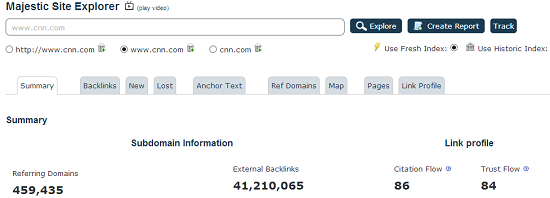Google’s PageRank is one of the most misused Web analytics metric. While it is generally understood by SEOs you shouldn’t use this metric to define campaign success, it is still a metric provided by Google to get a feel of what kind of “neighborhood” you’re in. I still show the metric to clients as they are more aware of it, but personally I like to rely on a wider array of metrics to get a better feel for a shifts in ranking.
PageRank is not current
Google’s PR was last updated Feb. 4th of this year (the previous update was Aug. 2nd, 2012). This metric gets updated 3-4 times a year; future dates are unknown and don’t seem to follow any pattern. Can you really measure the outcomes of your efforts with a metric updates about once a quarter? There are two sites I frequent to get a more up to date snapshot on how websites I track are doing: MajesticSEO and OSE. For Majestic, while there is a ton of useful data there, you should start off by looking at Citation Flow & Trust Flow. The first is a weighted metric based on the number of citations given to a URL or domain. Citations don’t necessarily have to be a clickable link on the referring domain, it’s just whether you are mentioned or not. Trust Flow is weighted by the number of clicks it takes to get to your website from a trusted “seed”. While there are numerous seeds Majestic cultivated, just consider this metric as how long is the path to get from a source like CNN or the NY Times to you.
For Open Site Explore (OSE), look at Page Authority. Their simple definition is the score representing the likelihood of a page to rank well, regardless of content. How they calculate this isn’t entirely public, but they do a few things to come up with the numbers. In short, they take all the ranking signals they know or believe to be important factors to Google and come up with their own ranking model for tens of thousands of keywords and compare them with what Google is returning. The correlation was at about 70% the last I saw the creation of PA was discussed, which is pretty decent. So with that correlation, they will give individual pages a score based on the metrics included in their model. PA (there is also Domain Authority on OSE), Trust Flow and Citation Flow are all on a 100 point scale.
Majestic has a Fresh index & a Historic index. Fresh, as in, it is updated every day. While your metrics may not change every day, the data collected will. PA and DA are updated at least once a month, but in recent months, as they are trying to get faster, I have seen updates twice a month.
A More Precise Metric
PR is on a 1-10 scale. So if you have a PR4, there is a significant effort required to move to PR5, which makes this process a difficult to measure. The bluntness of this grading scale makes it difficult in monitoring a competitor. As mentioned above, the Majestic and OSE metrics provide a finer grained view of shifting popularity. With this it is possible to measure smaller changes and much more useful as a trend measuring tool.
Depth of Information
Google’s PR is report as a stand alone number without any qualifying information. In addition to that, since the paper published by Sergey Brin and Larry Page in 1998, any enhancement to the algorithm are closely guarded secrets. However, the metrics provided by Majestic & SEOMoz (creator of OSE) are more of an open book. While they don’t tell you exact calculations, the data that is used by both companies is transparently presented.
3rd Party Data is Getting Better
PageRank has been devalued by Google employees themselves. Here is a quote from a Google employee from their Webmaster Help forum.
“We only update the PageRank displayed in Google Toolbar a few times a year; this is our respectful hint for you to worry less about PageRank, which is just one of over 200 signals that can affect how your site is crawled, indexed and ranked. PageRank is an easy metric to focus on, but just because it’s easy doesn’t mean it’s useful for you as a site owner.”
“We’ve been telling people for a long time that they shouldn’t focus on PageRank so much; many site owners seem to think it’s the most important metric for them to track, which is simply not true. We removed it because we felt it was silly to tell people not to think about it, but then to show them the data, implying that they should look at it”.
I won’t say Google is moving on from PR, or already has, but the other metrics like Trust & Citation Flow get a lot more attention from their caretakers to improve those metrics. So much has happened in the past few years when Google first started down playing PageRank, you can assume the shifting landscape of search engine rankings doesn’t involve well cultivated PR algo updates.
A More Complete Picture
While it doesn’t hurt to look at PR, and can give you a nice 10,000 foot view of where you stand, for a more in depth understand of where you stand, any blogger or SEO should be pulling in these types of metrics to get a better feel for how any campaign you are working on is progressing. I don’t necessarily think you should completely ignore PR, but don’t rely on it. Here are a couple reasons on why I still look at it for clients.
- The ancestry effect. Clients tend to recognize the name and may look for it
- It’s a published Google metric, giving it authority & trust to the client
- The numbers may be out of date, but is an important factor in how many pages on a site are indexed
Like I said, don’t completely discard PR just yet, but hopefully you’re going to add a much larger arsenal of metric weapons to track just how well you are doing. Educate your clients about both tools, and take advantage of having multiple metrics to evaluate and report on your popularity.


